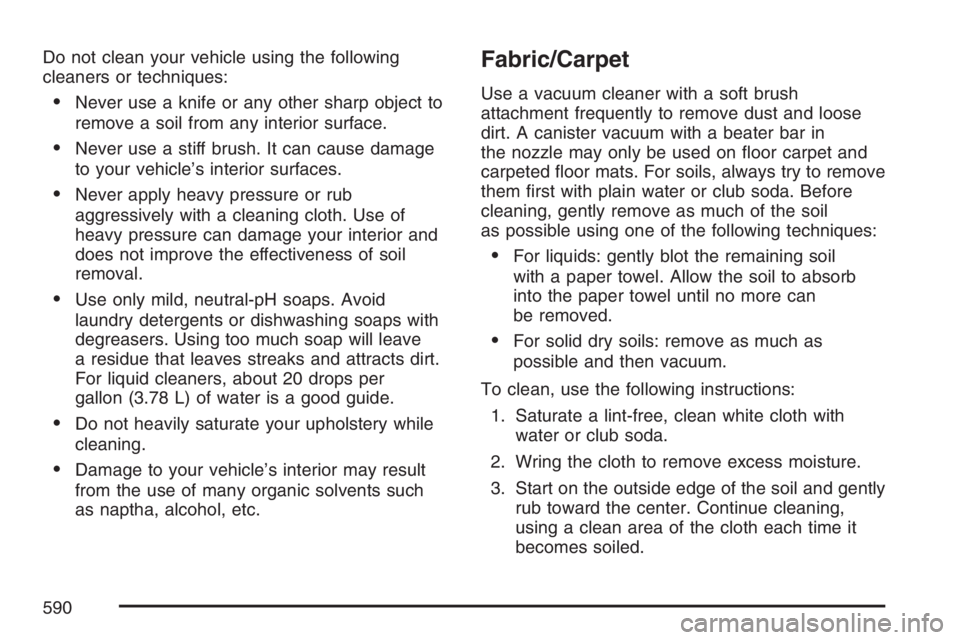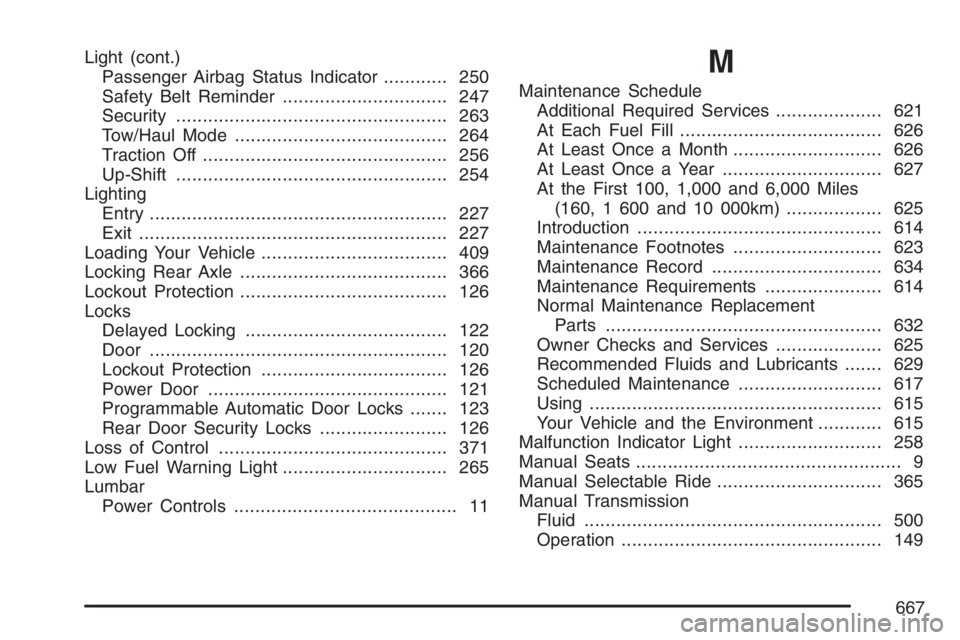Page 460 of 674

Auxiliary Battery
The auxiliary battery provision can be used to
supply electrical power to additional equipment that
you may choose to add, such as a slide-in camper.
If your vehicle has this
provision, this relay will
be located on the
passenger’s side of the
vehicle, next to the
auxiliary battery.
When using this provision, connection should only
be made to the upper stud (A) of the relay. Do not
make connections to the lower stud (B) of the relay.
The auxiliary battery circuit is protected by a
megafuse located behind the auxiliary battery.
Be sure to follow the proper installation instructions
that are included with any electrical equipment
that you install.Notice:Leaving electrical equipment on for
extended periods will drain the battery. Always
turn off electrical equipment when not in
use and do not use equipment that exceeds
the maximum amperage rating for the auxiliary
battery provision.
Power Winches
If you wish to use a power winch on your vehicle,
only use it when your vehicle is stationary or
anchored.
Trailer Recommendations
You must subtract your hitch loads from the CWR
for your vehicle. Weigh your vehicle with the
trailer attached, so that you won’t go over
the GVWR or GAWR. If you are using a
weight-distributing hitch, weigh the vehicle without
the spring bars in place.
You’ll get the best performance if you spread out
the weight of your load the right way, and if
you choose the correct hitch and trailer brakes.
For more information, seeTowing a Trailer
on page 429.
460
Page 590 of 674

Do not clean your vehicle using the following
cleaners or techniques:
Never use a knife or any other sharp object to
remove a soil from any interior surface.
Never use a stiff brush. It can cause damage
to your vehicle’s interior surfaces.
Never apply heavy pressure or rub
aggressively with a cleaning cloth. Use of
heavy pressure can damage your interior and
does not improve the effectiveness of soil
removal.
Use only mild, neutral-pH soaps. Avoid
laundry detergents or dishwashing soaps with
degreasers. Using too much soap will leave
a residue that leaves streaks and attracts dirt.
For liquid cleaners, about 20 drops per
gallon (3.78 L) of water is a good guide.
Do not heavily saturate your upholstery while
cleaning.
Damage to your vehicle’s interior may result
from the use of many organic solvents such
as naptha, alcohol, etc.
Fabric/Carpet
Use a vacuum cleaner with a soft brush
attachment frequently to remove dust and loose
dirt. A canister vacuum with a beater bar in
the nozzle may only be used on �oor carpet and
carpeted �oor mats. For soils, always try to remove
them �rst with plain water or club soda. Before
cleaning, gently remove as much of the soil
as possible using one of the following techniques:
For liquids: gently blot the remaining soil
with a paper towel. Allow the soil to absorb
into the paper towel until no more can
be removed.
For solid dry soils: remove as much as
possible and then vacuum.
To clean, use the following instructions:
1. Saturate a lint-free, clean white cloth with
water or club soda.
2. Wring the cloth to remove excess moisture.
3. Start on the outside edge of the soil and gently
rub toward the center. Continue cleaning,
using a clean area of the cloth each time it
becomes soiled.
590
Page 667 of 674

Light (cont.)
Passenger Airbag Status Indicator............ 250
Safety Belt Reminder............................... 247
Security................................................... 263
Tow/Haul Mode........................................ 264
Traction Off.............................................. 256
Up-Shift................................................... 254
Lighting
Entry........................................................ 227
Exit.......................................................... 227
Loading Your Vehicle................................... 409
Locking Rear Axle....................................... 366
Lockout Protection....................................... 126
Locks
Delayed Locking...................................... 122
Door........................................................ 120
Lockout Protection................................... 126
Power Door............................................. 121
Programmable Automatic Door Locks....... 123
Rear Door Security Locks........................ 126
Loss of Control........................................... 371
Low Fuel Warning Light............................... 265
Lumbar
Power Controls.......................................... 11M
Maintenance Schedule
Additional Required Services.................... 621
At Each Fuel Fill...................................... 626
At Least Once a Month............................ 626
At Least Once a Year .............................. 627
At the First 100, 1,000 and 6,000 Miles
(160, 1 600 and 10 000km).................. 625
Introduction.............................................. 614
Maintenance Footnotes............................ 623
Maintenance Record................................ 634
Maintenance Requirements...................... 614
Normal Maintenance Replacement
Parts.................................................... 632
Owner Checks and Services.................... 625
Recommended Fluids and Lubricants....... 629
Scheduled Maintenance........................... 617
Using....................................................... 615
Your Vehicle and the Environment............ 615
Malfunction Indicator Light........................... 258
Manual Seats.................................................. 9
Manual Selectable Ride............................... 365
Manual Transmission
Fluid........................................................ 500
Operation................................................. 149
667